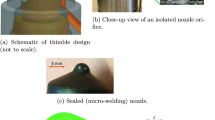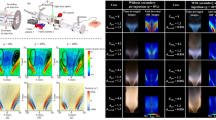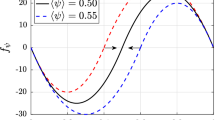Abstract
The main objective of the present experimental study is to analyze the turbulent structure in humid air non-premixed flame, and determine the effect of humidity on the flow field and the flame stability limit in turbulent non-premixed flame. Particle Image Velocimetry (PIV) is used to capture the instantaneous appearance of vortex structures and obtain the quantitative velocity field. The distributions of Reynolds shear stress, mean and root-mean squared fluctuating (rms) velocities are examined to get insight into the effect of fuel-to-air velocity ratio on velocity flow field. The results show that with steam addition, the air-driven vortex in the bluff-body wake is thinner; the biggest peaks of rms velocity and Reynolds shear stress are lower; the distance between the peaks of rms velocity on the sides of centerline reduces. Besides these, the flame stability is affected. Both central fuel penetration limit and partially quenching limit reduce with steam addition.
Similar content being viewed by others
References
Lupandin, V., Romanov, et al, Design, Development and Testing of a Gas Turbine Steam Injection and Water Recovery System, ASME Paper No. 2001-GT-0111.(2001).
Dryer, F. L., Water Addition to Practical Combustion Systems—Concepts and Applications,” Sixteenth Symposium International on Combustion, The Combustion Institute, Pittsburgh, PA. (1976).
Miyauchi, Y., Mori, Y., and Yamaguchi, T., Effect of Steam Addition on NO Formation, Eighteenth Symposium International on Combustion, The Combustion Institute, Pittsburgh, PA. (1981).
Blevins, L. G., and Roby, R. J., An Experimental Study of NOx Reduction in Laminar Diffusion Flames by Addition of High Levels of Steam, ASME Paper No. 95-GT-327.
A. Bhargava, M. Colket, et al., An experimental and modelling study of humid air premixed flames. J. Eng. Gas Turbines Pwr. Vol.122, pp.405–411, (2000).
A. Katoh, M. Shinoda, et al., Visualization of steam addition effect on OH distribution in a flame by isotope shift/planar laser-induced fluorescence (IS/PLIF) spectroscopy, Journal of Engineering for Gas Turbines and Power. Vol,128, pp.8–12,(2006).
Chen A G, Maloney D J, Day W H., Humid air NOx reduction effect on liquid fuel combustion, Journal of Engineering for Gas Turbines and Power, vol.126, pp.69–74, (2004).
K. Midgley, A. Spencer, J.J. McGuirk, Unsteady Flow Structures in Radial Swirler Fed Fuel Injectors, J. Eng. Gas Turbines Pwr. Vol.127, pp.755–764, (2005).
R. Perrin, M. Braza, et al. Near-wake turbulence properties in the high Reynolds number incompressible flow around a circular cylinder measured by two- and three-component PIV, Flow Turb. Combust. Vol.77, pp. 185–204, (2006).
P.O. Hedman, T.H. Fletcher, et al. Observations of flame behavior in a laboratory-scale premixed natural gas/air turbine combustor from planar laser induced fluorescence measurements of OH, laser Doppler anemometer velocity measurements, and coherent anti-Stokes Roman spectrometer temperature measurements, J. Eng. Gas Turbines Pwr. Vol.127, pp.724–738, (2005).
Williams FA, Progress in knowledge of flamelet structure and extinction, Prog Energy Combust Sci. vol.26, pp.657–682, (2000).
Author information
Authors and Affiliations
Rights and permissions
About this article
Cite this article
Ge, B., Zang, SS. & Guo, Pq. Experimental study on turbulent structure of humid air flame in a bluff-body burner. J. Therm. Sci. 18, 185–192 (2009). https://doi.org/10.1007/s11630-009-0185-3
Received:
Published:
Issue Date:
DOI: https://doi.org/10.1007/s11630-009-0185-3




